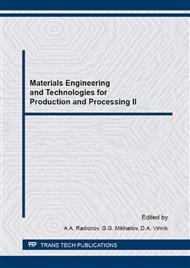p.516
p.523
p.528
p.535
p.539
p.545
p.550
p.558
p.564
Experimental Substantiation of a Method of Improving the Efficiency of Ultrasonic Drilling of Small Diameter Holes
Abstract:
Based on the analysis of trends in the development of aviation and rocketry and ground transportation, the prospect of use of high-alloy steels, and titanium-based alloys with high strength, heat-and corrosion-resistant properties is established. It is shown, that high strength and elasticity of mentioned alloy groups adversely affect the dynamics of cutting process and the resistance of the cutting tool. Processing of small diameter holes is especially difficult due to the small longitudinal stability of the instrument, chip evacuation problems, grooves sticking to the surface almost zero cutting speed near the core. The results from the analysis of works of domestic and foreign scientists have shown that the message sent to the drill by ultrasonic vibrations of the small amplitude reduces axial force and cutting moment due to reduced friction caused by local thermal effects and relief of dislocation motion. At the same time, it is stated that the stable results of the effectiveness of ultrasound were not received in relation to the small diameter end tools until recently because of additional dynamic loads reducing the longitudinal stability and therefore it is impossible to report the instrument optimal oscillation amplitude to facilitate cutting. The working hypothesis of increase of efficiency of the ultrasonic drilling of small diameter holes proposes to consider correlation frequency supplied to the ultrasonic instrument, structural parameters and physical and mechanical properties of the material and to drive oscillations in the plane of the main cutting edges which would significantly reduce the magnitude of the oscillation amplitude. Experimental studies on ultrasound indentation, micro cutting and drilling titanium alloys have confirmed this hypothesis. It was established that at the moment the drill receives a message with the oscillation frequency of 30 kHz when machining titanium alloys, the axial cutting forces decrease by 70 – 80 % and the tool life increases by 2.2 times.
Info:
Periodical:
Pages:
539-544
Citation:
Online since:
September 2016
Authors:
Keywords:
Price:
Сopyright:
© 2016 Trans Tech Publications Ltd. All Rights Reserved
Share:
Citation:


